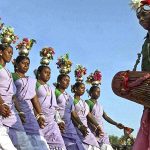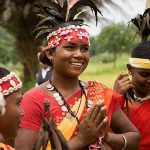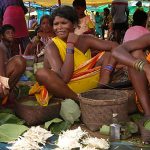Madhya Pradesh
Madhya Pradesh is home to 46 officially recognized tribes, including three Particularly Vulnerable Tribal Groups (PTGs).
Madhya Pradesh, a central jewel of India, is renowned for its remarkable tribal diversity. This state, with its extensive tribal population, boasts a myriad of distinct tribes, each with its own unique cultural and social characteristics. The tribes of Madhya Pradesh are primarily concentrated in the southern regions of the state, and their lives are intricately woven with ancient customs and traditions, which, while reminiscent of Hindu practices, remain deeply rooted in their own orthodox beliefs.
Gonds: The Largest Tribal Group
Among the most notable tribes is the Gond, the largest tribal group in Madhya Pradesh. Gonds predominantly inhabit the areas flanking the Narmada River in the Mandla, Chhindwara, Betul, and Seoni regions, as well as the hilly terrains of the Vindhya and Satpura ranges. The Gonds of Bastar, in particular, remain relatively isolated due to the rugged terrain, preserving their traditional way of life. Descendants of the Gonds include the Agaria, Pradan, Ojhan, and Solahas tribes, each carrying forward the Gond legacy in their own unique ways.
Bhils: The Warrior Tribe
The Bhils, the second-largest tribal group, are primarily found around Jhabua, Khargone, Dhar, and Ratlam. Known for their historical prowess as warriors, the Bhils have a reputation for their exceptional guerrilla tactics. Their martial skills and distinct cultural practices set them apart as a significant part of Madhya Pradesh’s tribal landscape.
Baigas: The Mystical Tribe
The Baiga tribe considers themselves descendants of the Dravidians. They are known for their role as priestly figures among the Gonds, engaging in magical practices and claiming knowledge of evil spirits. The Baigas predominantly reside in Mandla, with a notable settlement in Baiga Chak. They are passionate about agriculture, hunting, and forestry, embodying a blend of spiritual and practical skills.
Sahariya: The Tiger Companions
The Sahariya tribe, found mainly in the northwest districts of Gwalior, Shivpuri, Bhind, Morena, Vidisha, and Raisen, holds a special place in Madhya Pradesh’s tribal mosaic. The name “Sahariya” combines “Sa” (companion) and “Haria” (tiger), translating to “companion of the tiger.” Traditionally, the Sahariya practiced shifting cultivation, hunting, and gathering. They are devoted worshippers of Goddess Durga and have a rich cultural heritage rooted in their agrarian lifestyle.
Abujhmar: The Enigmatic Tribe
The Abujhmar tribes are among the most secluded and enigmatic in Madhya Pradesh. Their habitats, covered by dense forests, have kept their way of life relatively unknown to the outside world. Known for their unorthodox dietary habits—such as consuming red ants and rats—the Abujhmar people are characterized by their simplicity and primal nature. Their attire is minimal, with women traditionally going bare-chested and men wearing only loincloths.
Other Notable Tribes
The list of tribes in Madhya Pradesh extends further to include the Bharia, Korku, Santia, Kols, Savaras, and Banjaras. The Banjaras, in particular, are wandering tribes with roots linked to European gypsies, known by various names such as Lamani, Lambadi, Bangala, Banjori, and Banjuri. Their migratory lifestyle and diverse nomenclature add a layer of intrigue to their cultural identity.
Each tribe in Madhya Pradesh contributes to a rich and diverse cultural heritage, reflecting a spectrum of traditional practices, social customs, and economic activities. From the fierce Bhils to the mystical Baigas and the reclusive Abujhmar, the tribal communities of Madhya Pradesh offer a window into the deep and varied traditions that define this central Indian state.
Social Share

At Primitive Tales, we delve deeply into the essence of primitive life… much before urbanization came in. Our focus extends to the history of the tribes, their art, architecture, religion, and an overview on their life, one will enhance and gather fresh and new insights and experiences, enhancing our understanding of diverse cultures and enriching human understandings.




